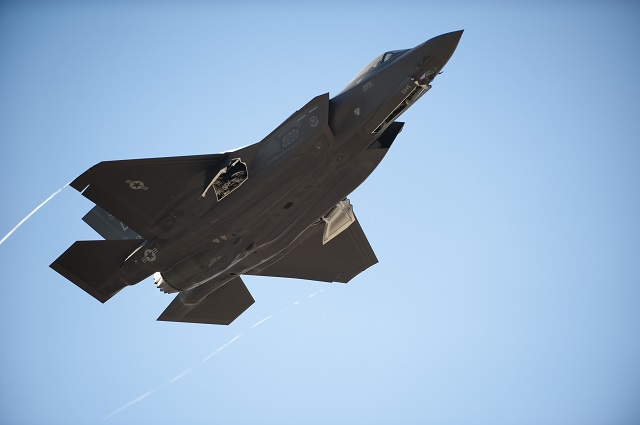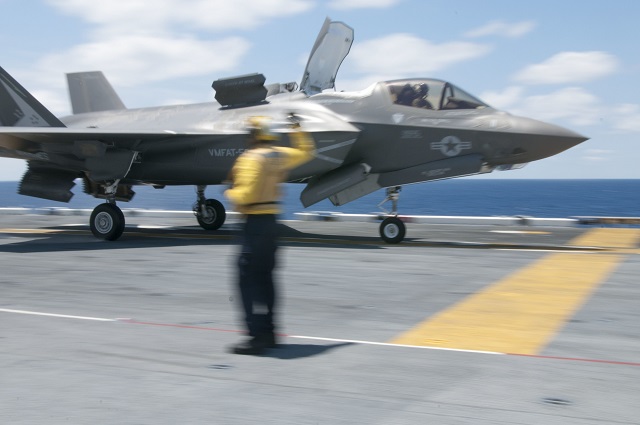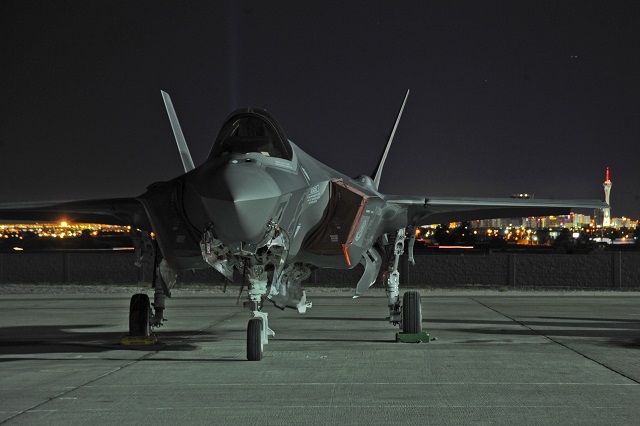As the Pentagon decides what new combat capabilities to “bake” into the Block 4 configuration of the Lockheed Martin F-35 Joint Strike Fighter, there is concern about planned upgrades sliding beyond Block 3F, and about the overall price tag as those modifications are rolled out in the early 2020s.
“We’ve seen programmes where our appetite is more than we can afford,” Maj Gen Jeffrey Harrigian, who heads the US Air Force F-35 integration office, said at a recent Mitchell Institute event in Washington, DC.
The air force expects its first squadron of 12 to 14 A-model F-35s in the baseline Block 3i configuration to be ready for combat in a limited capacity by August 2016. But each aircraft will need to be modified to achieve “full warfighting capability” with the full suite of armaments and improvements provided in the subsequent Block 3F and Block 4 upgrades.

Harrigian says the F-35 joint programme office is currently defining exactly what will be included in Block 4 ahead of a Pentagon requirements review later this year. Once approved, the configuration will be the baseline for future Block 4 increments as they are rolled out every two years or so.
The general’s two main concerns are “sliding things from 3F into Block 4” and affordability. He says the air force is in discussions with the joint programme office and the F-35 industry team about how best to stage the delivery of new capabilities so they are inserted at the right time and at the right cost.
“We’re trying to be as clear-eyed on what we think we can afford to make sure as we go through [increments] 4.1 and 4.2 we’ve got our priorities straight,” he says.
The Marine Corps is in the final stages of F-35B operational testing aboard the amphibious assault ship USS Wasp as it works to achieve initial operational capability in the Block 2B configuration in July. Those aircraft along with the early air force Block 3i jets will be capable of conducting limited air-interdiction and close-air-support operations with basic guided bombs and air-to-air missiles.

Block 3F adds all of the weapons qualified during the system development and demonstration phase including the Boeing Small Diameter Bomb I, Raytheon AIM-120D Advanced Medium-Range Air-to-Air Missile, AIM-9X Sidewinder and General Dynamics 25mm gun. Other weapons being considered for Block 4 include Raytheon’s Small Diameter Bomb II and Kongsberg’s Joint Strike Missile, among others. Block 4 might also include integration with the B61-12 guided nuclear bomb being developed by the US Air Force, National Nuclear Security Administration and Boeing.
The first air force squadron will stand up at Hill Air Force Base in Utah starting with the first aircraft delivery this September. That base is followed by Eielson AFB, Alaska, in July 2019 and then Burlington Air National Guard Base, Vermont, in July 2020, Harrigian says.
If all goes according to plan, Royal Air Force Lakenheath in the United Kingdom will receive its first US F-35s in 2021.
Production of the F-35 is expected to scale up significantly over the next five years, growing from 123 aircraft now to more than 650 operated by the US and six other international programme partners by 2020.

Harrigian says air force senior leaders “feel very comfortable” about achieving initial operational capability in 2016. However, he says some of the largest challenges the air force is working on right now include reducing the time it takes to populate the aircraft’s mission data file with operational information; ensuring an adequate amount of resources and aircraft are available for mission qualification training; and managing software glitches with the F-35 Autonomic Logistics Information System (ALIS), which tracks maintenance and repair work.
“The hardware for ALIS is going to come out later this fall,” Harrigian says. “What training do the maintainers need to manage that software once it’s received?”
The general says the head of the Air Combat Command will determine whether to certify the F-35 as combat-ready based on its performance conducting basic close air support, air interdiction and suppression and destruction of enemy air defences.
“This is just a pit-stop en route to the full warfighting capability that we’re going to bring,” he says.
Source: FlightGlobal.com



















